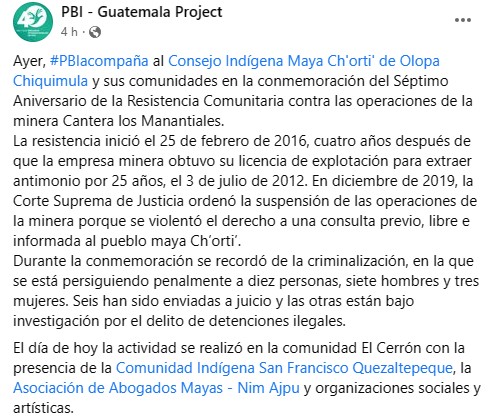This article was written by the Peace Brigades International- Canada Project

On February 26, PBI-Guatemala posted:
“Yesterday, #PBI accompanied the Maya Ch’orti’ Indigenous Council of Olopa Chiquimula and its communities in the commemoration of the Seventh Anniversary of Community Resistance against the operations of the mining company Cantera los Manantiales.
The resistance began on 25 February 2016, four years after the mining company obtained its mining licence to extract antimony for 25 years on 3 July 2012. In December 2019, the Supreme Court of Justice ordered the suspension of the mining company’s operations because it violated the right to free, prior and informed consultation with the Maya Ch’orti’ people.
During the commemoration, a reminder was made of the criminalization, in which ten people, seven men and three women, are being criminally prosecuted. Six have been sent to trial and the others are under investigation for the crime of illegal detentions.
Today the activity took place in the community of El Cerrón with the presence of the Indigenous Community of San Francisco Quezaltepeque, the Association of Mayan Lawyers – Nim Ajpu and social and artistic organizations.”

In 2019, Prensa Comunitaria reported:
“The company Cantera Los Manantiales, owned by Ovidio Guzmán, a well-known businessman in Esquipulas, has been operating for 7 years between the mountains of Olopa. Its activity has a direct impact on four communities: El Amatillo, Carrizal and La Prensa de Olopa and Carboneras de Chiquimula.”
And about this gathering, Prensa Comunitaria has also reported:
““As a Mayan people we are joining forces to be able to defend our territory against the threat of mining,” said Marvin Nájera, an indigenous authority from Quezaltepeque, hailing Olopa’s resistance. He reported that in his municipality there are requests for five mining projects.
The communities have denounced the impacts of mining projects, such as the cases of the Porvenir Quarry, in Camotán; El Manantial Quarry, in Olopa; El Pato mining project in Chiquimula, in the afforestation of hills and mountains such as the Merendón mountain.”

